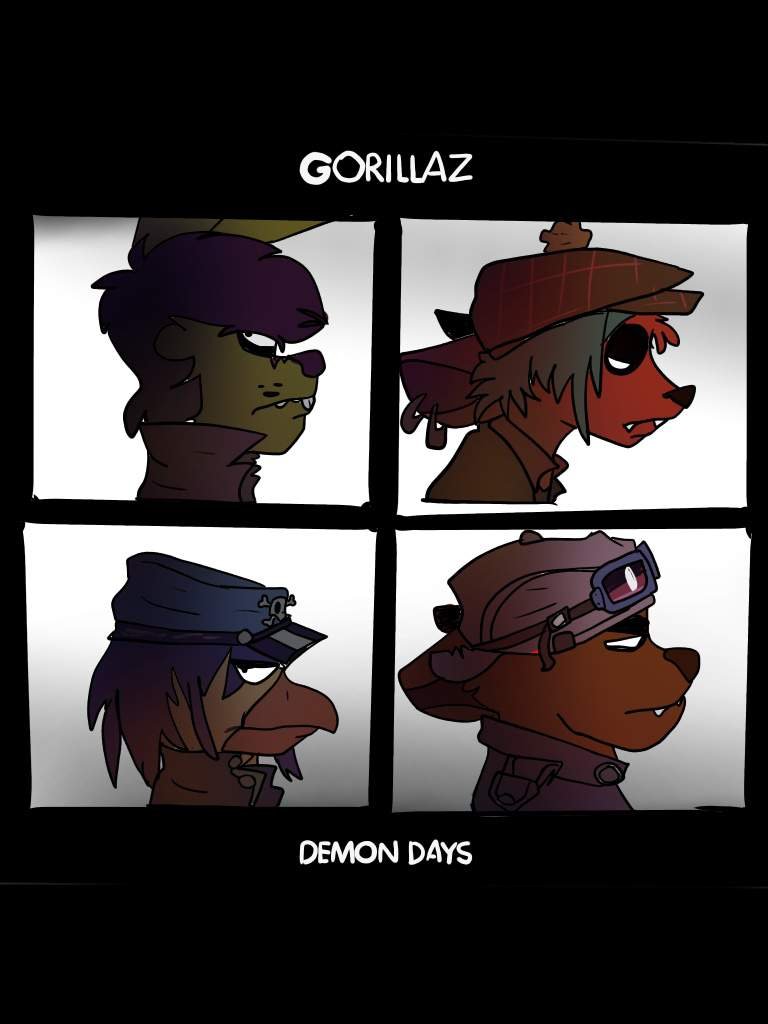


The resulting work was Demon Days – a series of musical collaborations that were carefully wrapped around Hewlett's singular aesthetic. Eager to prove critics wrong, Hewlett and Albarn teamed up again and attempted to repeat the process. A virtual band was a clever idea, but surely the idea wasn’t able to stretch to a second album. While the concept behind their first album had critics amused and entertained, many had felt it was to be a one-off stunt. Gorillaz promotional shot used during the release of Gorillaz (2001) by Jamie Hewlett, courtesy Parlophone Records. “Gorillaz may not be real,” Hewlett told The Guardian in 2001, “but they are no less so than the caricatures that are Marilyn Manson and Eminem”. While the illustrated existence of 2D, Murdoc, Russel and Noodle may have brought the idea of manufactured music to its logical conclusion, its irony was that their invented reality felt far more authentic than many of their musical rivals. Their emergence came at a time when postmodernism had permeated the mainstream, and Gorillaz unapologetic artifice felt refreshing in a world that was slowly submerging into the murky depths of hyperreality. Hewlett and Albarn’s confrontational characters served as a welcome distraction from reality TV, mass-produced boybands and the ever-growing popularity of celebrity culture. Source: Flood MagazineĪt the time, the media were delighted to go along with the satirical nature of a cartoon band.
#GORILLAZ DEMON DAYS ALBUM COVER INFO FULL#
It was a full blown viral marketing campaign – quite possibly the first to happen in the history of music. This wasn’t simply a few pictures rattled out by the illustrator. This was all in the year 2001 – a time when ninety-three percent of the world still had dial-up internet. The release came with a host of magazine covers, press appearances, music videos, cartoon clips, live projected performances and an animated website. Hewlett’s work wasn’t limited to simply illustrating the cover. When their self-titled debut emerged in 2001, it sold an impressive six million copies, and the band quickly became the most successful virtual band in the history of music. Members from left-to-right: Noodle, Russel, 2D and Murdoc. Despite these examples, it wasn’t until Gorillaz that the true potential of a virtual band was properly realised. Soon after them came groups like The Archies and Josie and the Pussycats even real-life acts like The Beatles, The Jackson Five and The Osmonds turned to cartoons as a means to reinvent themselves. Their novelty record from 1958 was a huge success, and they proved listeners were happy to get on board with a band that wasn’t real. Arguably, the first virtual band was Alvin and the Chipmunks. Pop’s relationship to fictitious bands dates back almost sixty years. One night they decided something had to be done to change it. As the station churned out a host of homogeneous acts, the two grew ever more frustrated with the growing monotony of manufactured music. Both had just come out of long-term relationships, and they were dragging themselves through life with late-night parties and an endless diet of MTV. 1968) found himself sharing a flat with the illustrator and cult-comic artist Jamie Hewlett (b. The story of this group dates back to the late-1990s when Blur’s Damon Albarn (b.

What was it that marked this fictitious four-piece out? Why did an illustrated band feel so relevant during the noughties? What advantages came from hiding behind a cartoon? While virtual bands had been around long before Gorillaz, none had ever quite seen their level of success. In a decade defined by its own uncertainty, it seems somewhat fitting that one of the most influential and progressive albums from the early two-thousands would come from a band that didn’t exist. Jamie Hewlett's cover artwork for Demon Days (2005) by Gorillaz, courtesy Parlophone Records.


 0 kommentar(er)
0 kommentar(er)
